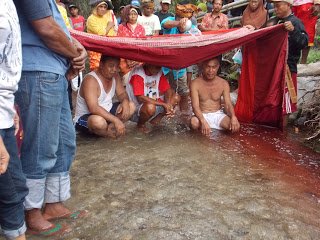The pounding of the gimba (drums) are mutually recited by the chanting of prayers that come from the mouths of a number of traditional elders, occasionally interspersed with hysterical screams of some residents who add to the mystical scent in the ritual being executed. That morning, Wednesday (2/3/2016), the atmosphere of Kelurahan Kawatuna, District Mantikulore, seemed deserted. No visible means of activity in the village located at the foot of Feather (mountain) Masomba.
2 kilometers west of Jalan Bulu Masomba, there is a low boisterous community as it is busy holding an event. Baruga located at the foot of the mountain is crowded with adat elders and community leaders from two villages namely Kawatuna and Lasoani. They look busy preparing the traditional ritual Pora'a Uve (blood flow in the water).
The customary ritual of Pora'a Uve was held by customary institution of Kawatuna and Lasoani Subdistrict. This ritual was carried out to ask for rain, after the last few months, Palu City experienced a prolonged dry season, causing dry farmland and water discharge at Uwentumbu river which became the water source of 3 urban villages namely Kawatuna, Lasoani, and Petobo. In fact, this river becomes the only source of water that people use to bathe, drink, and others.
The traditional elders believe, the drought that struck one of them because it has been a long time the ritual is not held. As a matter of fact, they routinely held the customary ritual so that although the dry season occurs, the flow of water in the river is not reduced and the rain always goes down.
Entering the area around the baruga place of ritual execution, mystical fragrance began to feel. The thump of the gimba (drums) played by a group of youths, shouted with the hysterical cries of the topeaju who broke the silence of the valley at the foot of the mountain.
The topeaju's mythical shouts and dances welcomed a number of important guests who arrived like members of the DPRD of Palu City, Thompa Yotokodi and Palu Mayor Hidayat. They were picked up by traditional elders and led to customary baruga while sprinkled with yellow rice by the customs.
Prior to the peak ritual in the traditional baruga, the traditional ritual of Pora'a Uve begins with visiting some ancestral graves for mompakoni (giving offerings as well as praying). The first tomb that was visited by the elders was the tomb (Dayo) Pue Sola Onge, which is about 300 meters from the customs baruga.
According to the Chief Customary of Kelurahan Kawatuna, H. Sudin Mandiguni, this pilgrimage ritual is done in order to say goodbye and pray to the ancestors to be given smoothness and ease in performing traditional rituals. In the ritual of the pilgrimage, the indigenous elders placed offerings containing sambulu gana and some Kangi typical snacks, while accompanied by the jolt of the gimba bersahutan with the cries of the community in attendance.
After finishing prayers and permits at Dayo Pue Sola Onge, a group of indigenous elders headed for a river about 500 meters from the baruga to perform the peak ritual of Pora'a Uve. At 11.30 WITA, Pora'a Uve's peak ritual was performed by slaughtering a white goat and a white chicken and the blood of the slaughtered animals flowed into the river until it touched a number of indigenous elders dressed in white sitting in the middle of the river and over it was laid out a red cloth . Those who are bathed and bathed must be the original offspring of Kawatuna, the majority inhabited by the Kaili dialect of Tara.
A number of these elders are bathed in water mixed with the animal's blood. The water used for the bath is flowed to everyone bathed through the red cloth. This bathing ritual is accompanied by the throb of gimba and shouts of mutual conversation. This ritual ends with a sprinkling of river water to the whole community and guests who witness the ritual.
After the bathing ritual, the traditional elders were accompanied by the pounding of the gimba and the topeaju dance, walking back towards the customary baruga. At the time of approaching the customary baruga, the group was also greeted by two other topeaju dancers who shouted at each other with topeaju dancers who accompanied the group. The group then boarded the baruga while sprinkled with yellow rice.
After all the entourage gathered in the customs baruga, the traditional elders then read the prayers of salvation and petition for sustenance eased and the flow of water in the river and the rain always increases. After the prayer readings, the traditional elders with the guests and the community lunch together and closed the entire procession of ritual.
Palu Mayor, Hidayat, hopes in the future customary rituals will be held regularly every year, because the younger generation today tend to not know and deepen the culture and custom, so there are many conflicts because the young have started behaving impertinently to the elderly.
Hidayat said, the customs of the ancestors are both held simultaneously with the efforts of environmental conservation. He requested that the community also keep the trees located in the forest around the settlement so as not to be felled carelessly. Even Hidayat said, in the future it will look for big bamboo seed from Java to be planted in the area around the baruga. This is according to Hidayat conducted to encourage the development of populist economy and micro business actors by utilizing bamboo as a raw material of its products.
